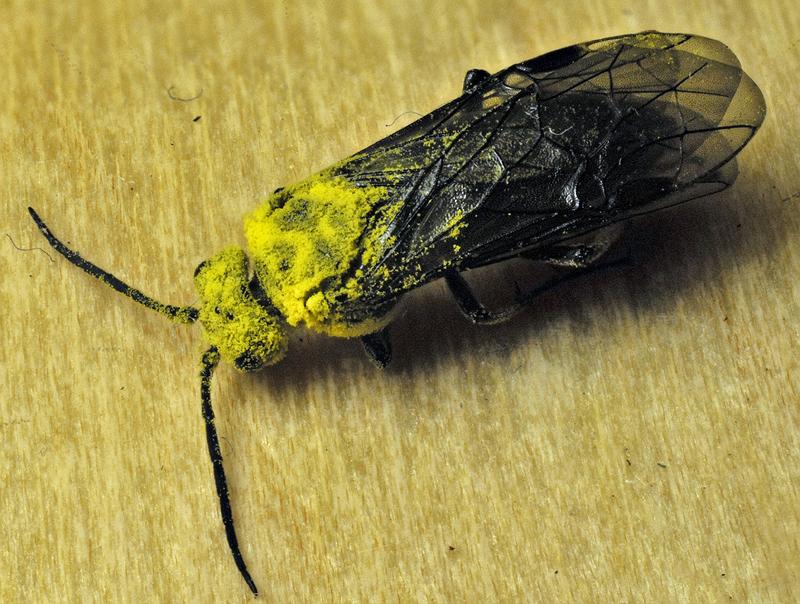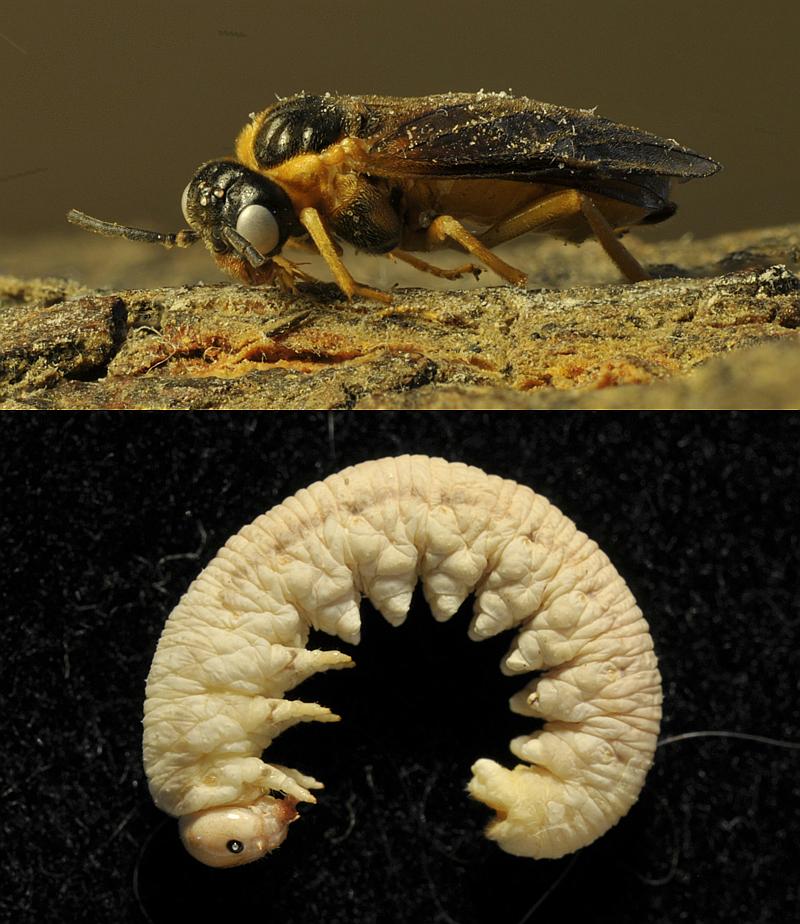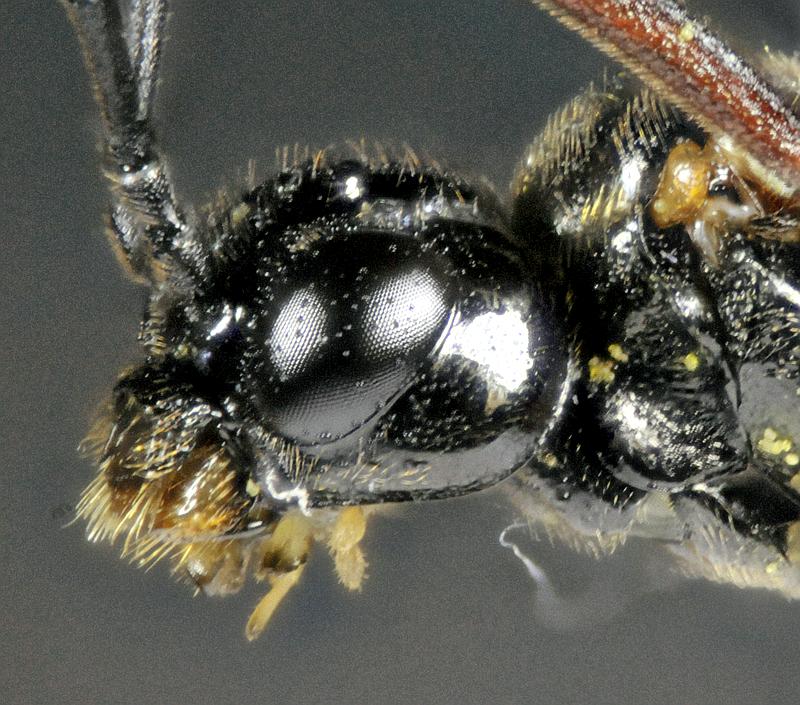Apoidea
There is a popular misconception that bees, honey bees (Apis mellifera) in particular, are the
primary pollinators of flowering plants. I have well over 100 different flowering plants in my
gardens, and (so far) 14 species of bees have visited. I'm not aware
of a single plant that's pollinated only by bees. At least half are visited solely by wasps
and/or flies.
|
|
Agapostemon texanus: These bees are attracted to the salt in human sweat, hence referred
to as sweat bees. This is one of the most common metallic greens here. Length 10 mm.
| |
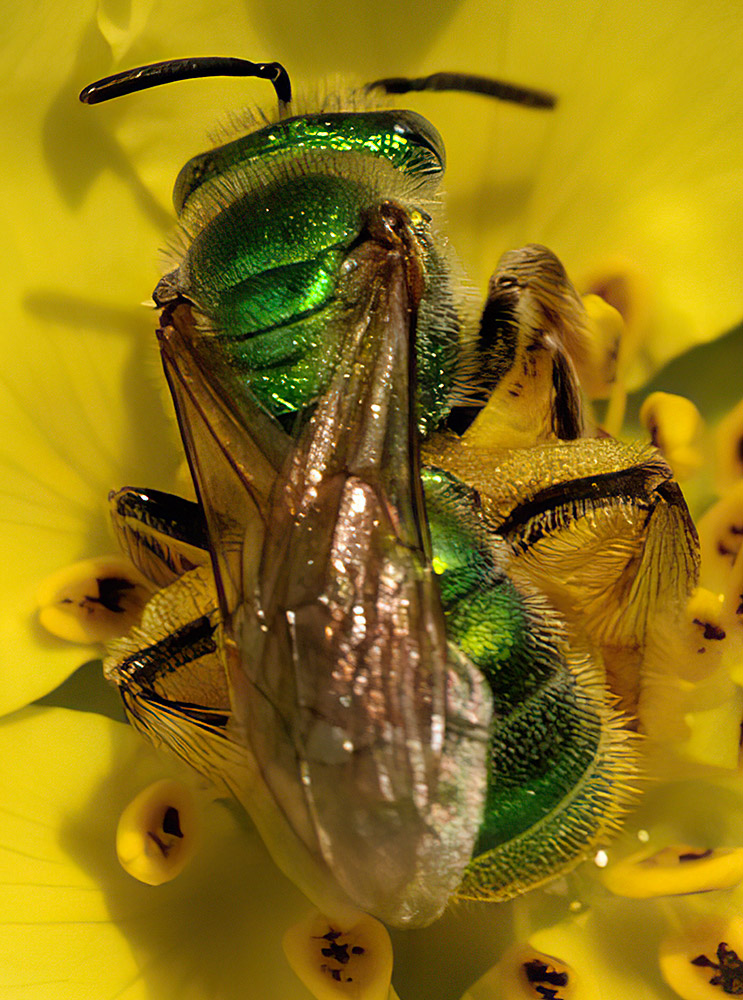

|
|
Agapostemon virescens: A communal sweat bee, many females share a single nest entrance
although each maintains individual areas within it. Length 9 mm.
| |
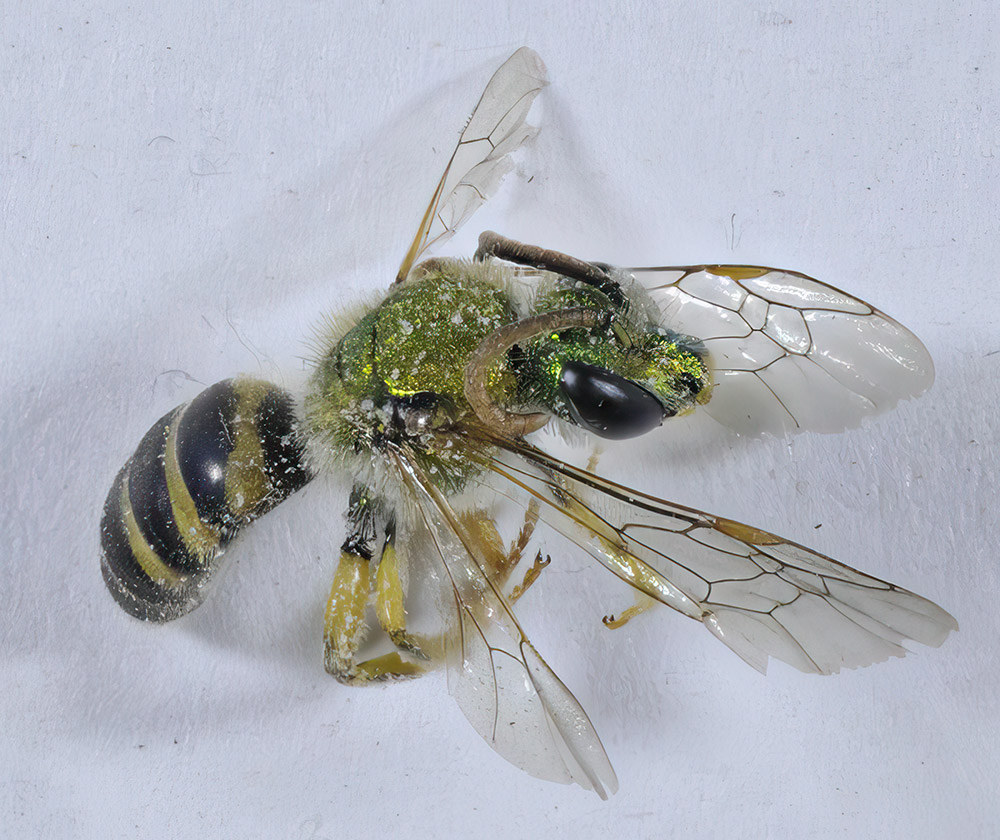

|
|
Andrena dunningi: This bee is rare here, but its large size and hairless black abdomen
stand out. It's eusocial, forming large colonies of individual burrows. Length 13 mm.
| |
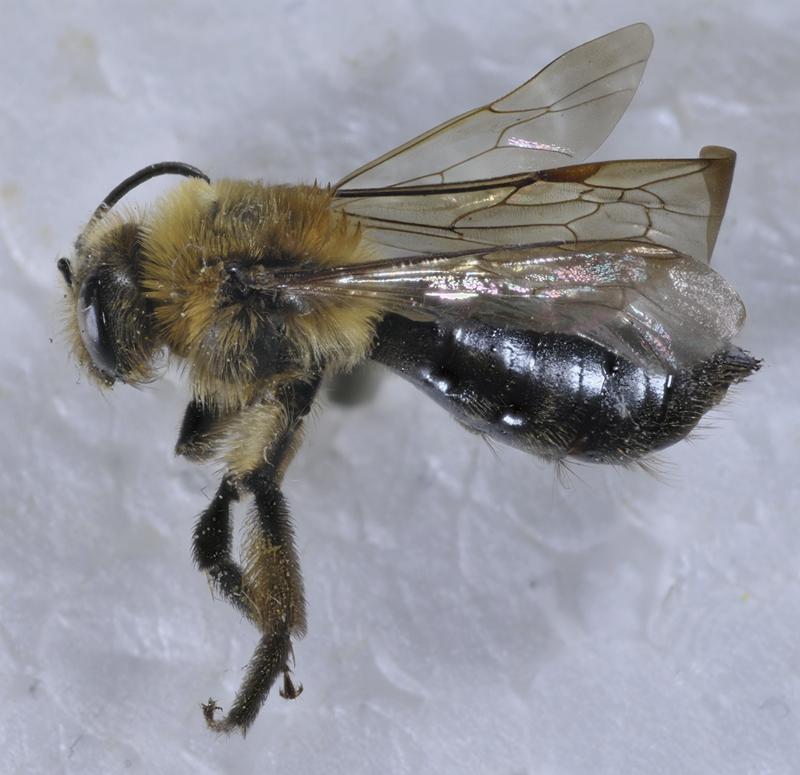

|
|
Andrena rugosa: These bees usually collect pollen as food and often fail to pollinate the
flower. They are my commonest bee and the earliest. Length 9 mm.
| |
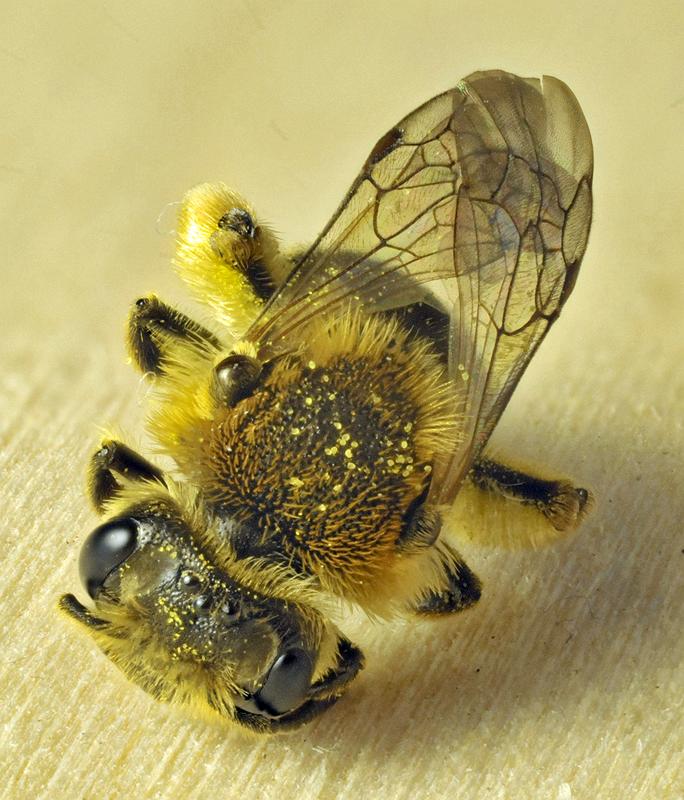

|
|
Apis mellifera: Honey Bees were brought from Europe in the 1600's, later from other
locations in Asia and Africa. Besides producing honey, hives are transported to pollinate field
and orchard crops, then moved out before pesticide spraying resumes. This one may have come from
a backyard apiary, if so it must be a fair distance away as they aren't common here. Length
12 mm.
| |
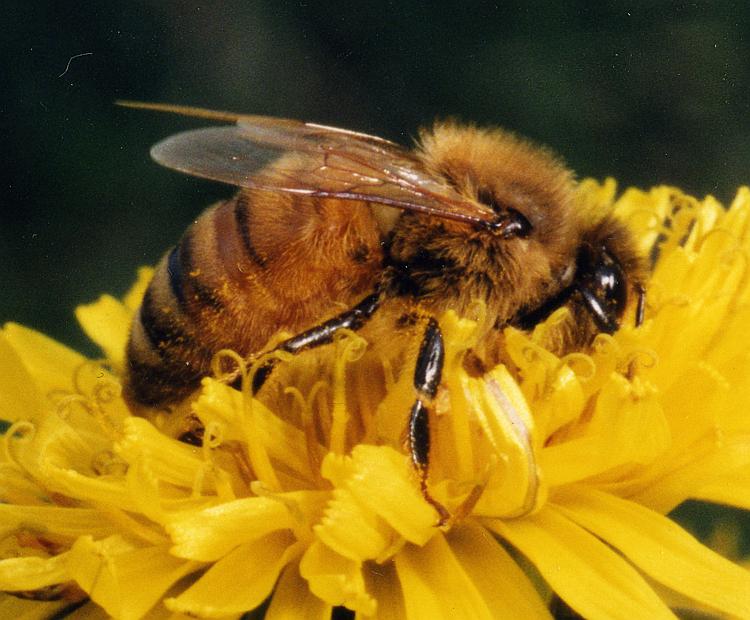

|
|
Anthidium manicatum is native to Europe and Africa, and appeared in North America in the
1960's. They are one of the few bee species in which the male is larger than the female. Females
comb wool fibres from plants to use as nesting material, while males fiercely guard areas of these
plants for potential mates. Length 16 mm; females are smaller.
| |
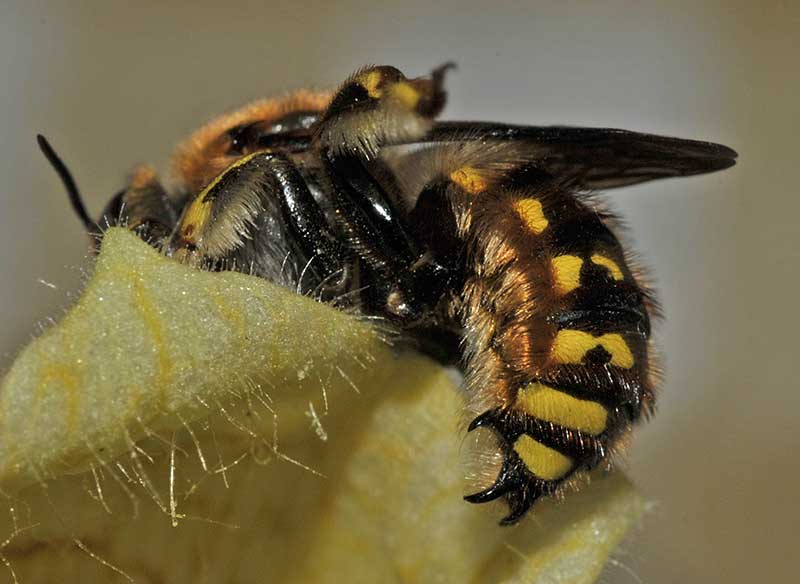

|
|
Bombus impatiens: Eastern Bumble Bees nest eusocially in several places in my garden, an
advantage of zero tillage. They can always be found collecting nectar from Clematis tangutica when
it's in bloom. They are more efficient pollinators than Apis mellifera as the vibration caused by
their powerful wings dislodges more pollen. Only queens survive winters.
Worker length 10-15 mm.
| |
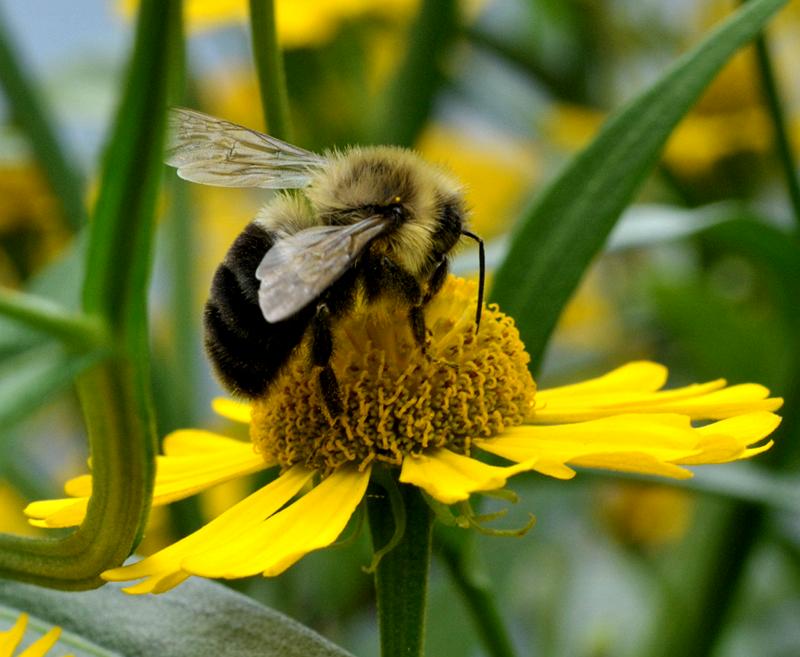

|
|
Bombus ternarius: Tricolored Bumble Bees are rarely seen in my garden, presumably the
resident B.impatiens discourage them from staying. Length 12 mm.
| |
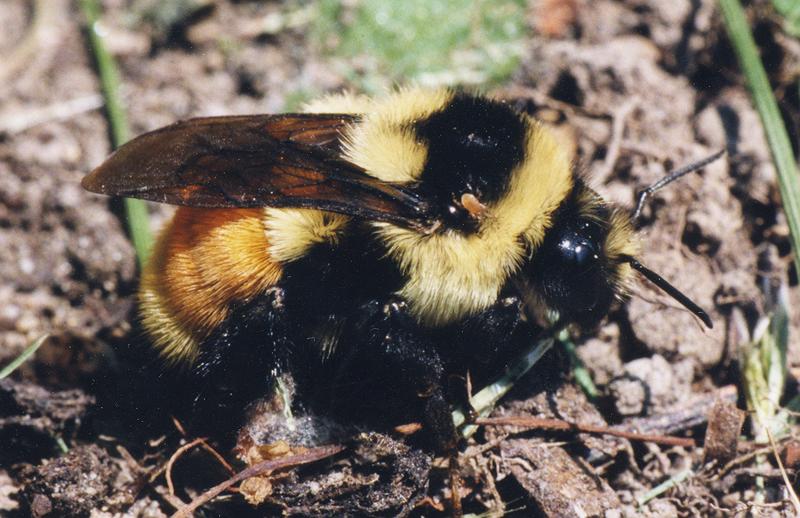

|
|
Colletes inaequalis: A ground nesting bee, it builds cells in underground nests that are
lined with a polyester secretion to preserve moisture during summer aestivation. Length 15 mm.
| |
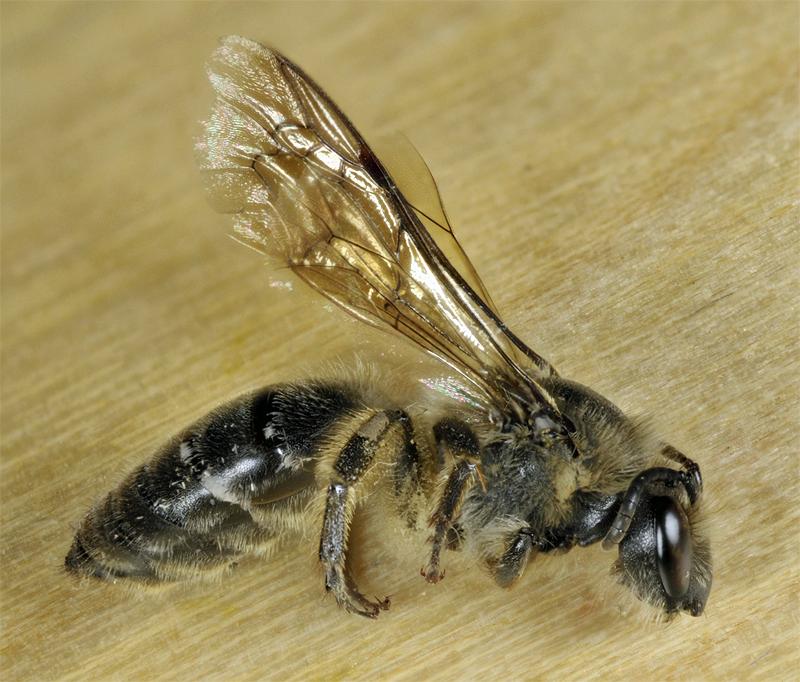

|
|
Halictus rubicundus: A solitary bee here, nesting in the ground; it's social in warmer
climates. Length 11 mm.
| |
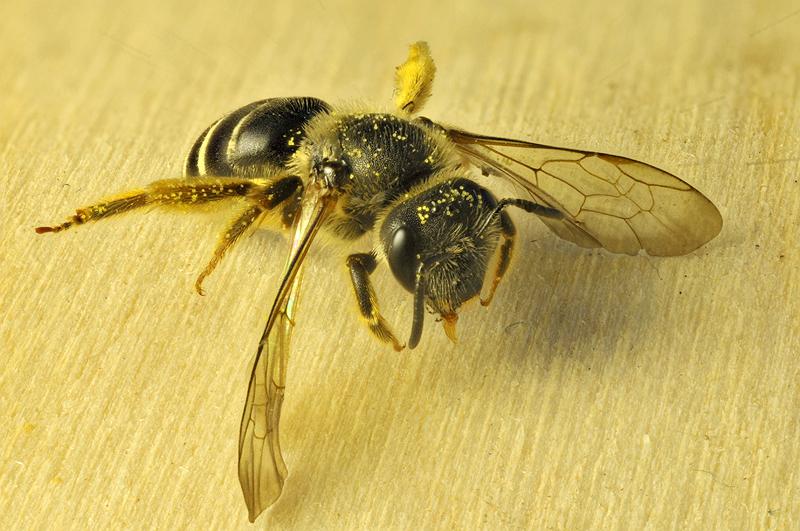

|
|
Lasioglossum ellisiae: This bee is an important native pollinator. Length 4.5 mm.
| |
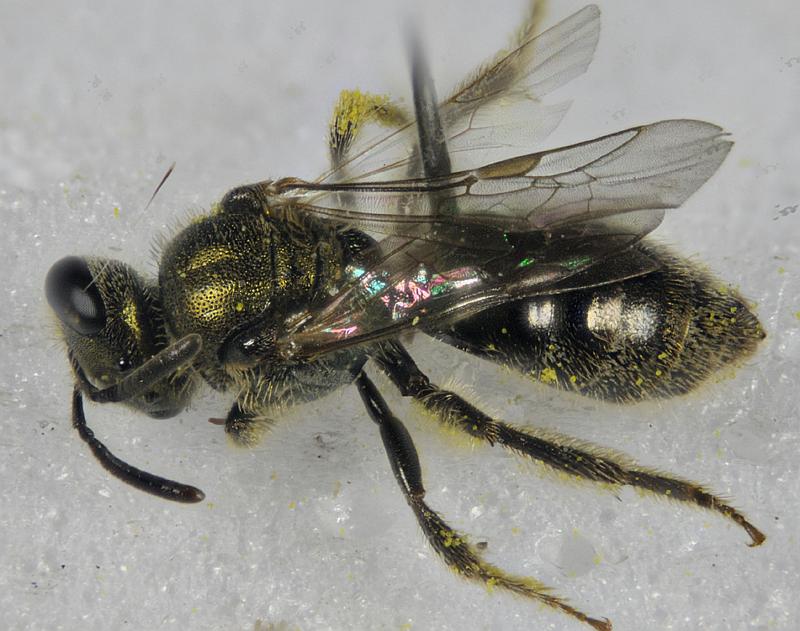

|
|
Lasioglossum fuscipenne: This is a eusocial bee - each nests in its own cell but some remain to guard
the nest complex while others forage for food. Length 6 mm.
| |
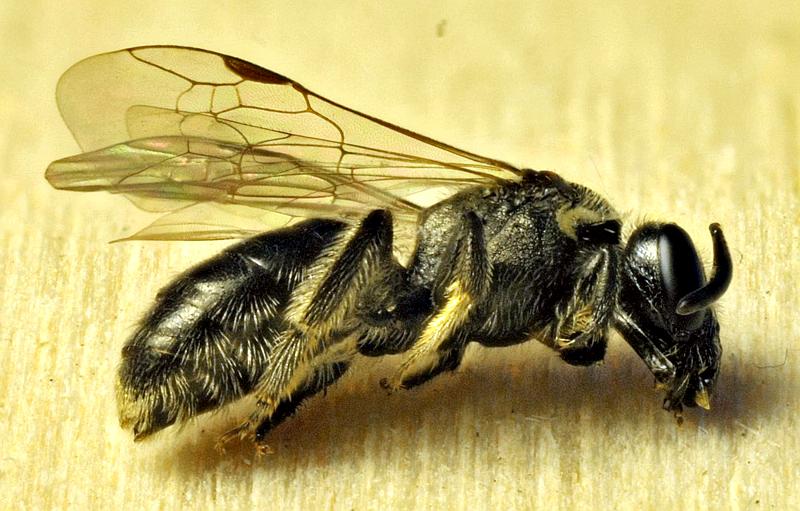

|
|
Nomada articulata: Cuckoo bees lay their eggs in ground-nesting bee burrows for others to raise. Males are
species-specific - they wait near a nest of their host species, then when a female appears fertilize her and
transfer to her pheromones of the host which presumably protect her and her egg from being attacked by the host bee.
However, it's the female Nomada that makes the final evaluation of nest suitability. Length 6 mm.
| |
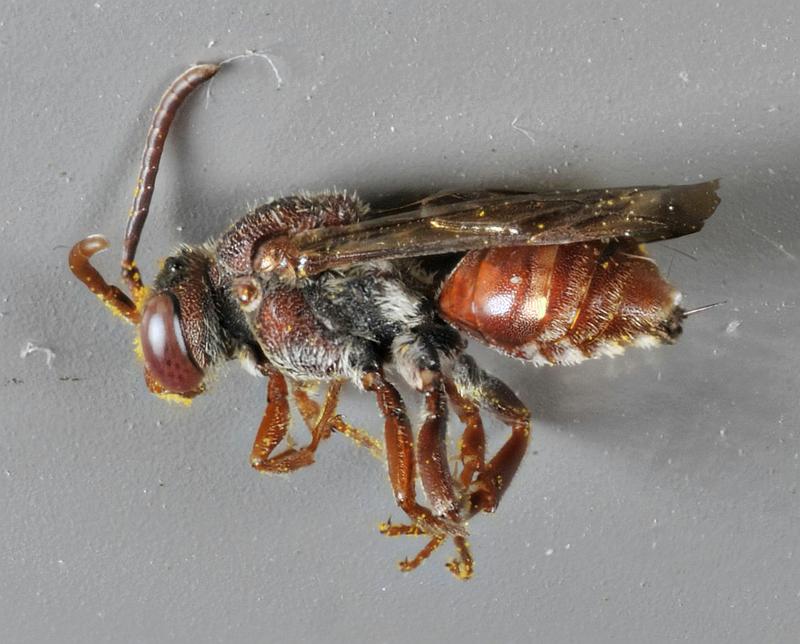

|
|
Nomada maculata: Another cuckoo bee, presumably targeting a different species than
N.articulata. Andrena vicina is known to be a target. Length 8 mm.
| |
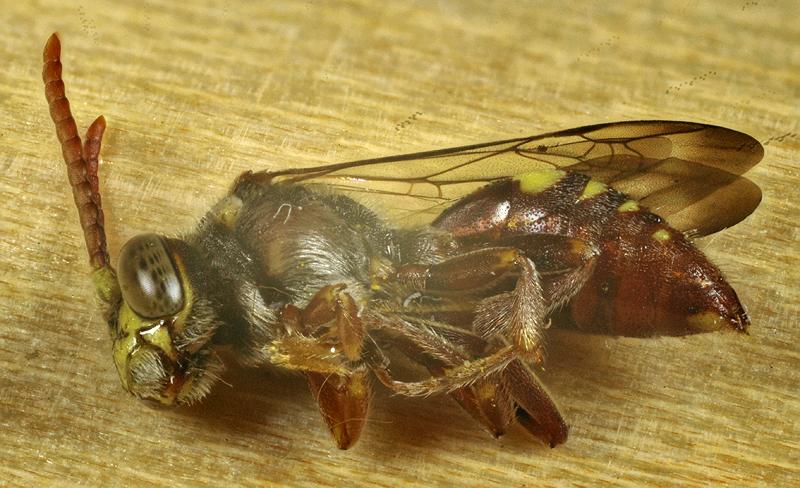

|
|
Nomada ruficornus: This bee was part of a small swarm of males furiously jockeying for top
position among Aurinia saxatilus blooms for a full day. All their wings were worn to a frazzle in
the effort. Length 9 mm.
| |
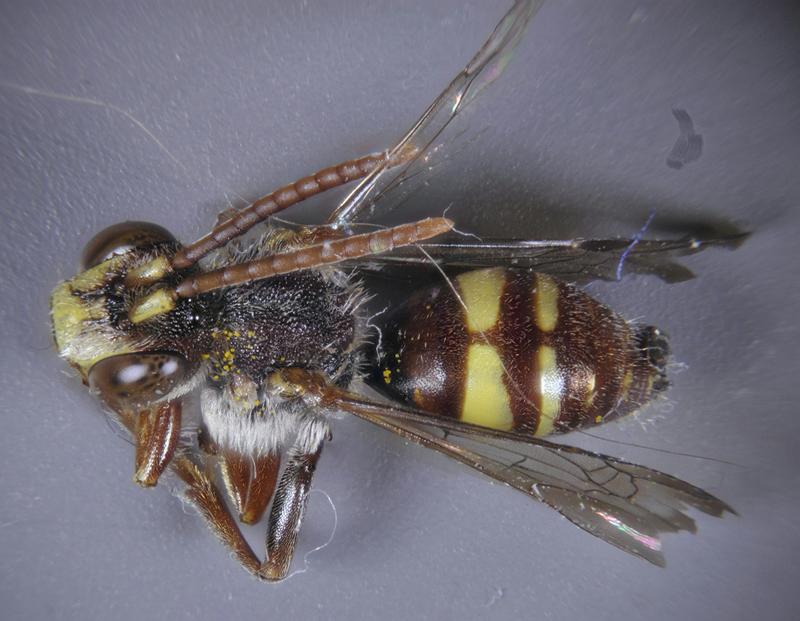

|
| Formicoidea
|
|
Camponotus noveboracensis: This ant is common in wet places and moist rotting wood such
as in my bog garden. Here one is lugging home part of a Nephrotoma ferruginea. Length 7 mm.
| |
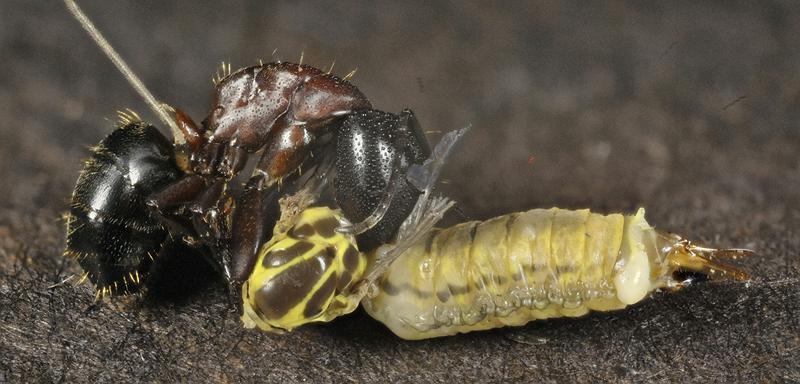

|
|
Camponotus pennsylvanicus: Black Carpenter Ants are omnivorous, eating just about anything
except the moist wood that they favour for excavating burrows. In a forest, they chew up tons of
wood and turn it into fine sawdust that rots and provides compost for new growth, but you don't
want to see them around your home! Whenever I spot one I move it to a local forest away from human
structures; length 16 mm.
| |
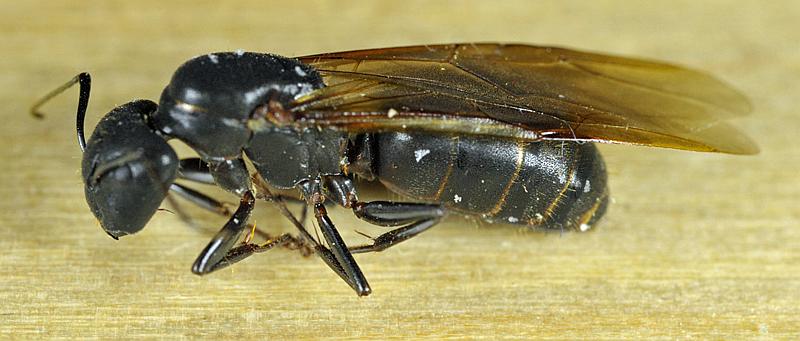

|
|
Formica dakotensis: This Red Wood Ant was introduced in 2015 with the aim of lending a hand
to my prized 12 m cedar clump; by late 2017 it had become the dominant species throughout the back
gardens. It can enslave most other Formica species, in my case F.fusca. The flat-topped petiole is
distinctive; body length 5 mm.
| |
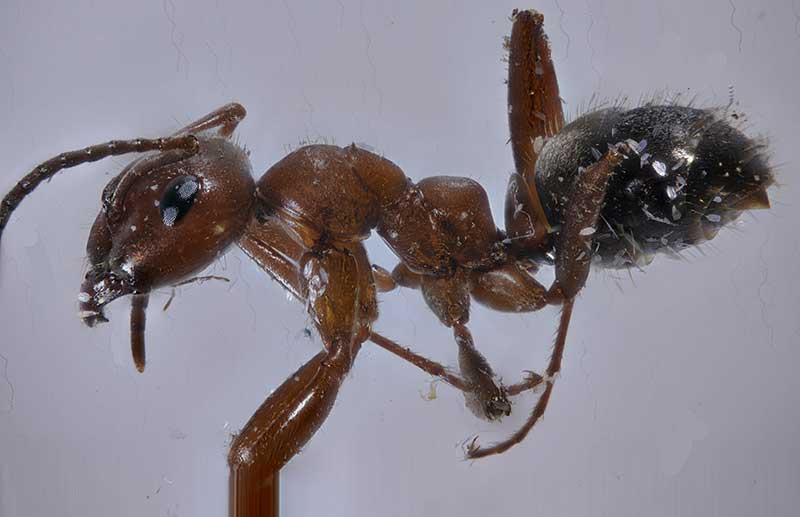

|
|
Formica fusca: Silky Ants are my primary front garden ant. Experts disagree as to whether
it is one species (Chapman) or up to half a dozen; meanwhile it just keeps piling sand up around its nest
entrances no matter what we say. Worker length 4 mm.
| |
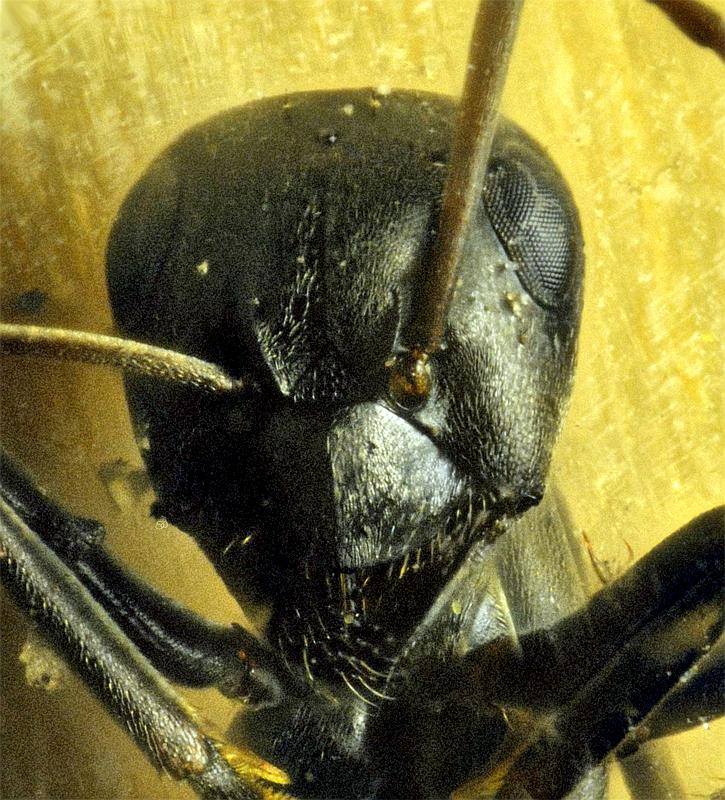

|
|
Formica pergandei: These slavemaker ants suddenly appeared in my front garden as a swarm
to steal eggs from the resident F.fusca; they'd stayed hidden under the sedum before. Once the
F.fusca pupate they'll do grunt work for the F.pergandei; worker length 5 mm.
| |
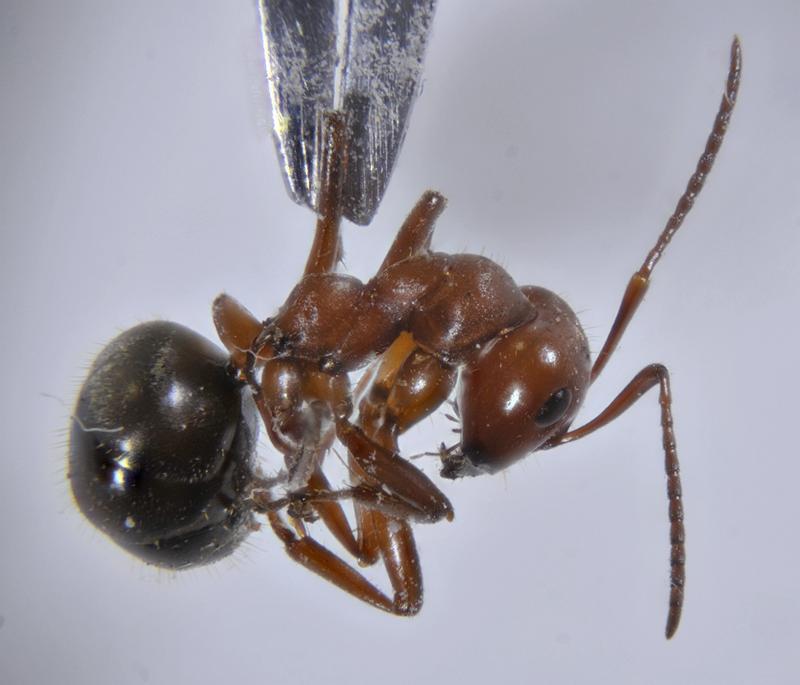

|
|
Lasius americanus: Taxonomists have decided that North American L.alienis are sufficiently
different from European ones that they deserve a new species name. Whatever they are called, they
are common in my back garden; the thorax shape is distinctive. Length 2 mm.
| |
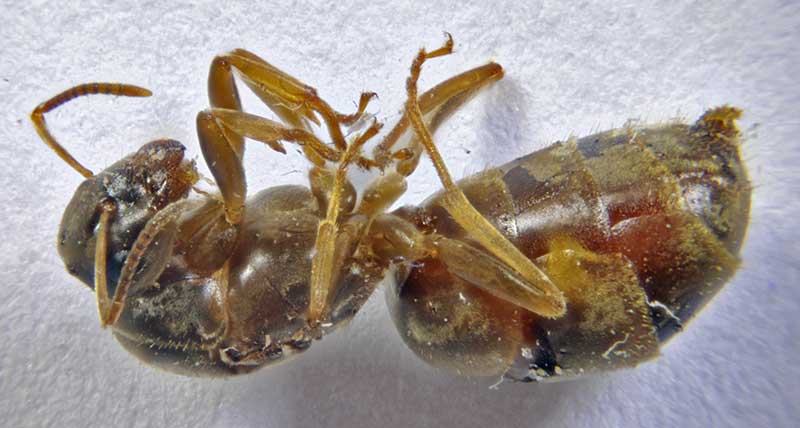

|
|
Lasius claviger: This ant was found briefly only in the sandy portion of the alpine garden;
length 6 mm.
| |
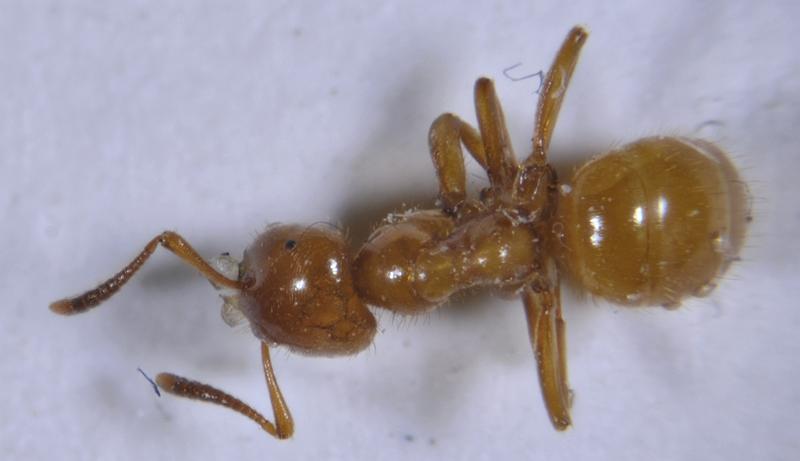

|
|
Myrmica americana: The wrinkled dorsum separates this species from others locally. Its
nests are usually soil chambers at the roots of grasses; the area it was collected was grass when
it was collected. Now that I've eliminated grass I no longer see it; length 5 mm.
| |
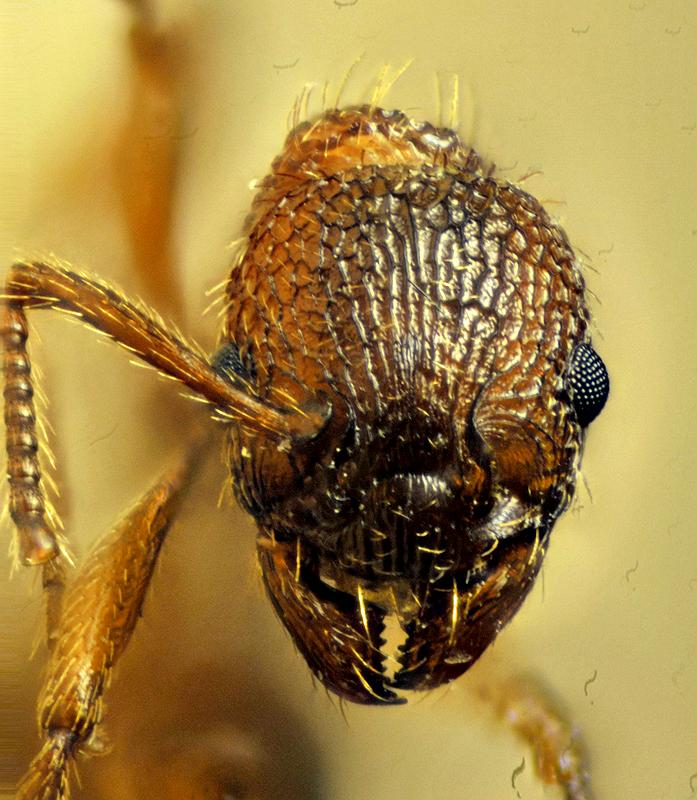

|
|
Tetramorium immigrans: This ant first appeared in my front interlock driveway in 2018,
and is now a massive colony.
| |
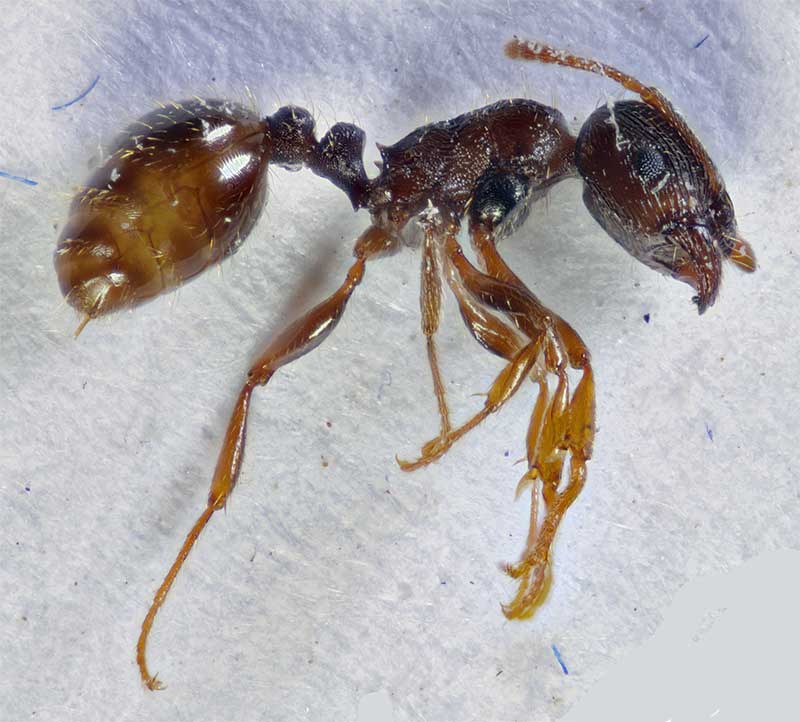

|
| Wasps (polyphyletic)
|
|
Acraspis villosa: A gall wasp that lays eggs in soft tissues in trees, flowers and other plants.
As the larvae develop, a gall forms and sometimes hinders the normal development of the plant.
This is a gall cut in half to show the grub.
| |
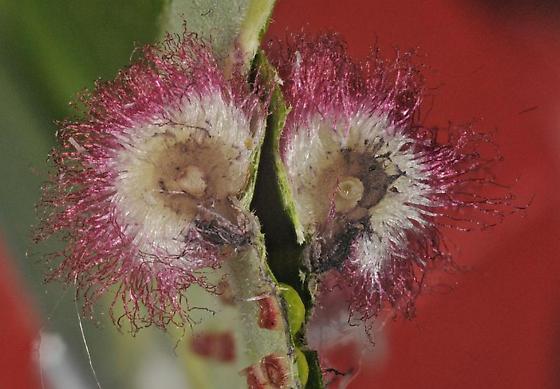

|
|
Aleiodes: Mummy wasps lay their eggs within host eggs. When the host caterpillar hatches,
so does the wasp. The caterpillar cadaver remains intact and identifiable as the Aleiodes larva
feeds and eventually pupates inside the caterpillar leaving the host mummy intact after the adult
wasp emerges. Length 4 mm.
| |


|
|
Anoplius: Spider wasps parasitize spiders. This one flew well despite the damage to its
wings, but the damage prevented using venation keys to species. Length 11 mm.
| |
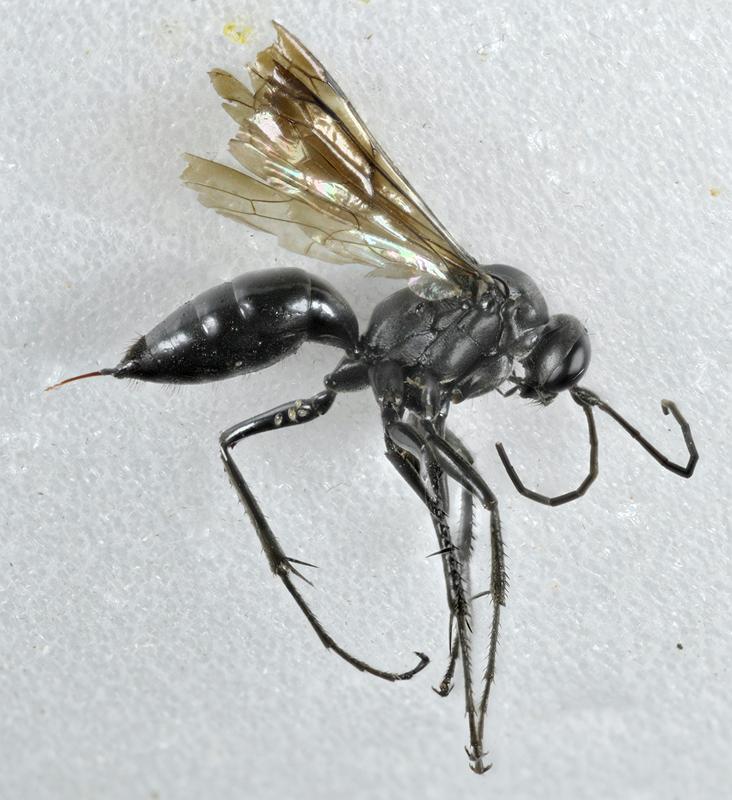

|
|
Arenetra: This little male wasp doesn't sting. It uses its long antennae to listen for
females to mate with; the females use theirs to listen for prey to lay eggs in. Length 20 mm.
| |
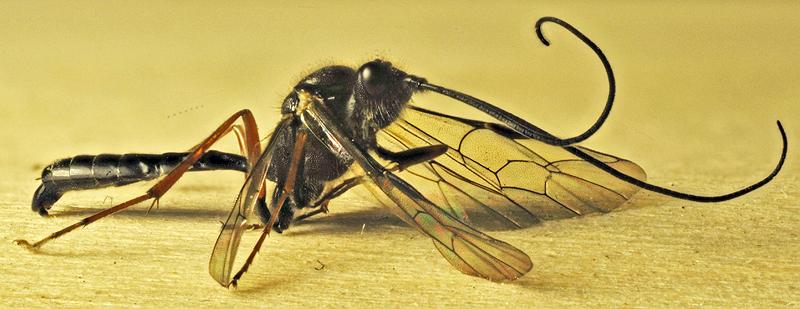

|
|
Bicyrtes quadrifasciatus: This sand wasp digs small burrows in sand to hold paralyzed
Heteroptera to feed its larva. Length 17 mm.
| |
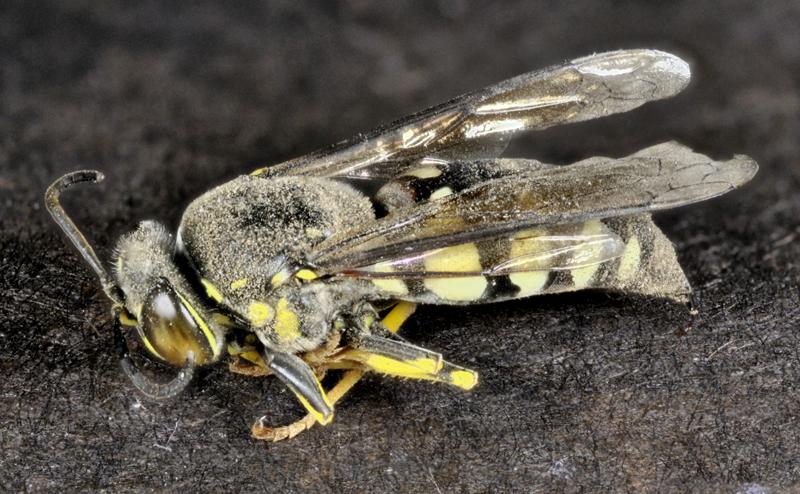

|
|
Ceropales maculata: This incredibly long legged spider wasp hunts other spider wasps
carrying prey, grabs the prey, lays an egg in it, then lets the original wasp do the work of
digging a burrow for it. The C.maculata egg hatches first, hunts down and eats the other wasp's
egg, then continues with the spider. What incredible things can be encoded in a single molecule
of DNA! Body length 7 mm.
| |
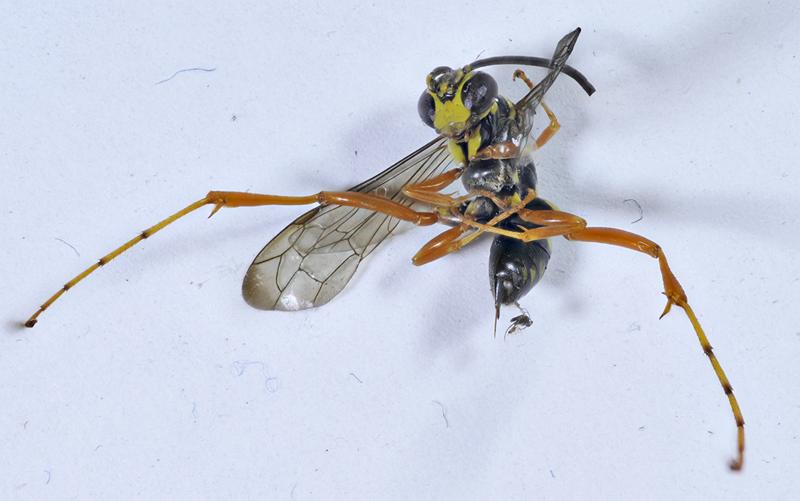

|
|
Chalybion californicum: This mud-dauber wasp makes frequent visits to the pond to collect
water. It flicks its wings distinctively every few seconds while doing so. Length 16 mm.
| |
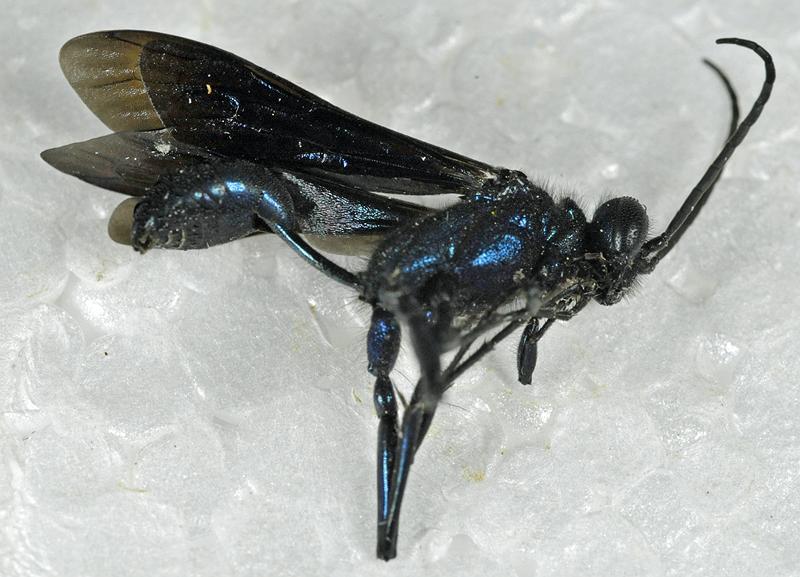

|
|
Coelichneumon neocretatus: Length 13 mm.
| |
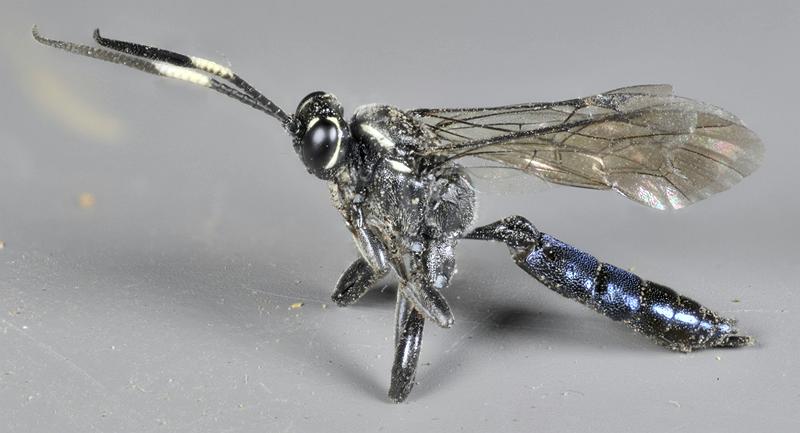

|
|
Dolichovespula maculata: There are three black&white Vespinae in Ottawa; they're not
easy to tell apart (https://bugguide.net/node/view/649028/bgimage). Nests of many of the group
are usually subterranean in rodent burrows, however, I've had a large nest of these ones under my
house eaves for several years now; a new one gets built each year. Unlike their cousin yellow
jackets, they never bother us at our picnic table. Length 18 mm.
| |
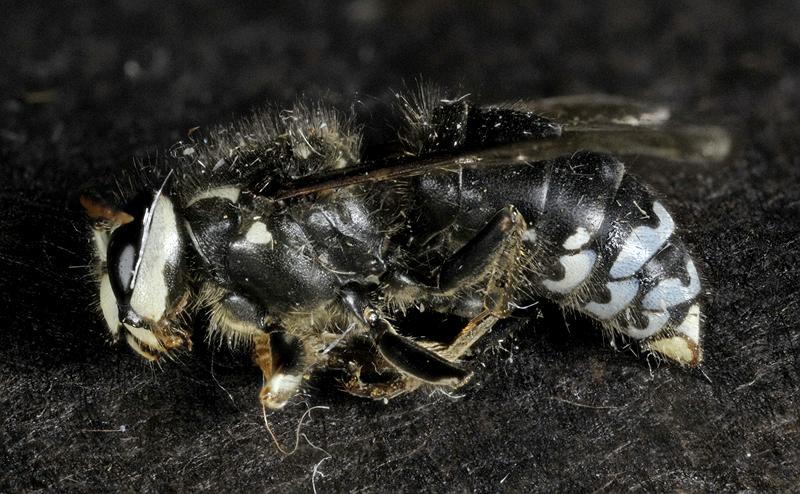

|
|
Eumenes verticalis: Potter wasps make their nests of mud; this one attaches it to rocks in
the nearby meadow. It feeds its larvae on caterpillars. Length 14 mm.
| |
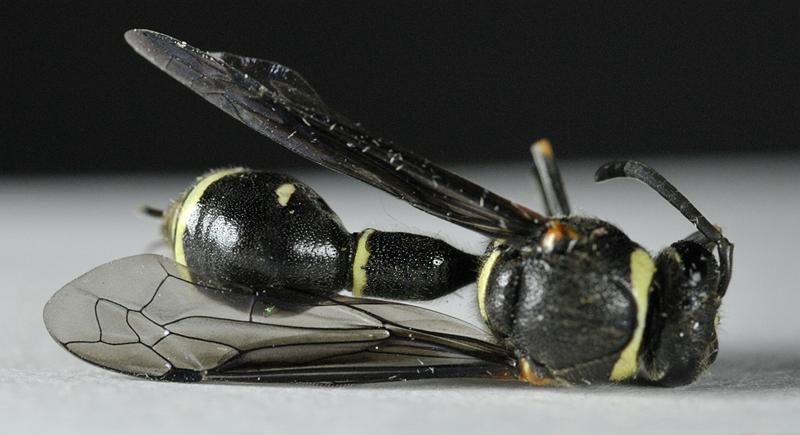

|
|
Homolobus truncator: An ichneumon wasp that specializes in armyworms and fruitworms; it's
valuable to commercial crop growers. Length 6 mm.
| |
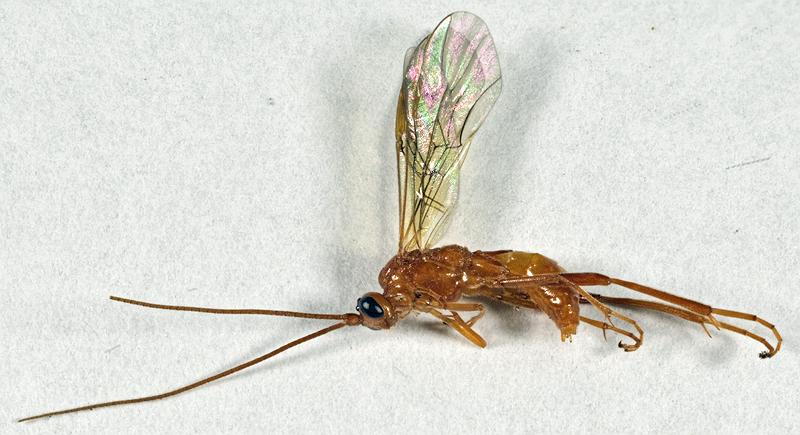

|
|
Ichneumonidae: Length 2 mm.
| |
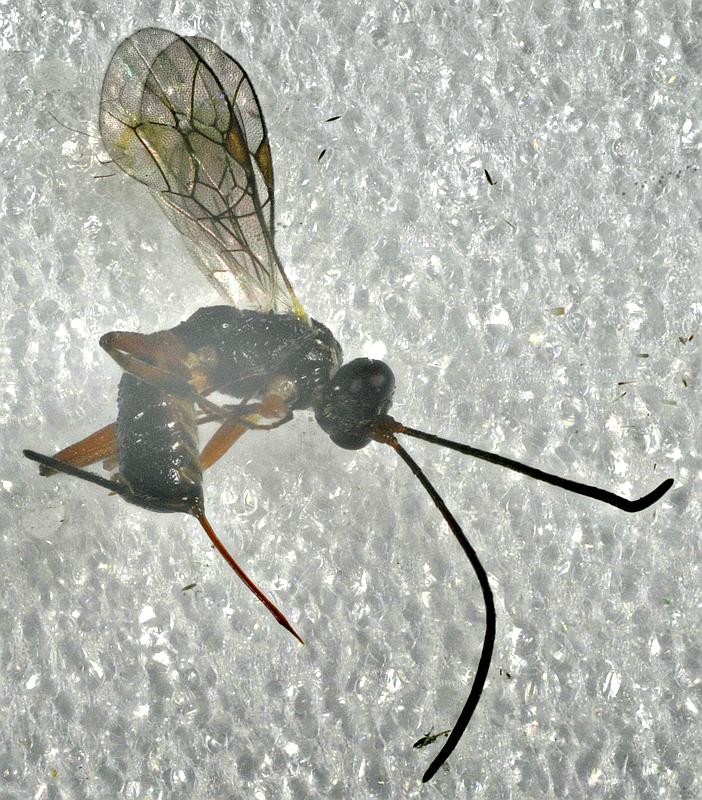

|
|
Macrocentrus: An ichneumon wasp. Length 3.4 mm.
| |
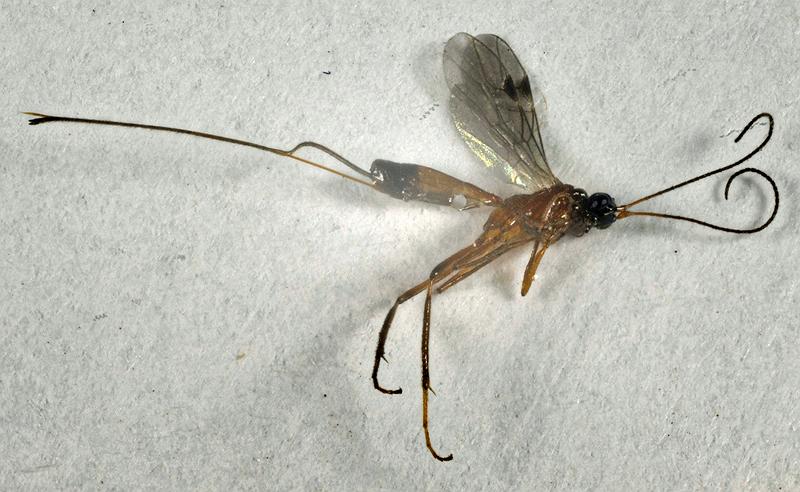

|
|
Megarhyssa atrata: This magnificent wasp stopped by briefly, I've never seen one with such a long ovipositor
before or since. Ichneumon wasps locate a grub buried deep in rotting wood, drill in to it and lay their egg in it.
After the larva has eaten the grub, it knows how to get out. Incredible technology! This one concentrates on Siricid
larvae. Ovipositor length 140 mm.
| |
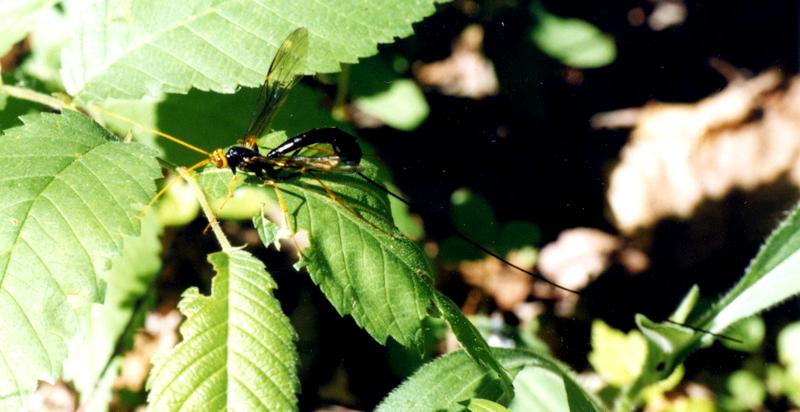

|
|
Mesostenus gracilis: Length 7 mm.
| |
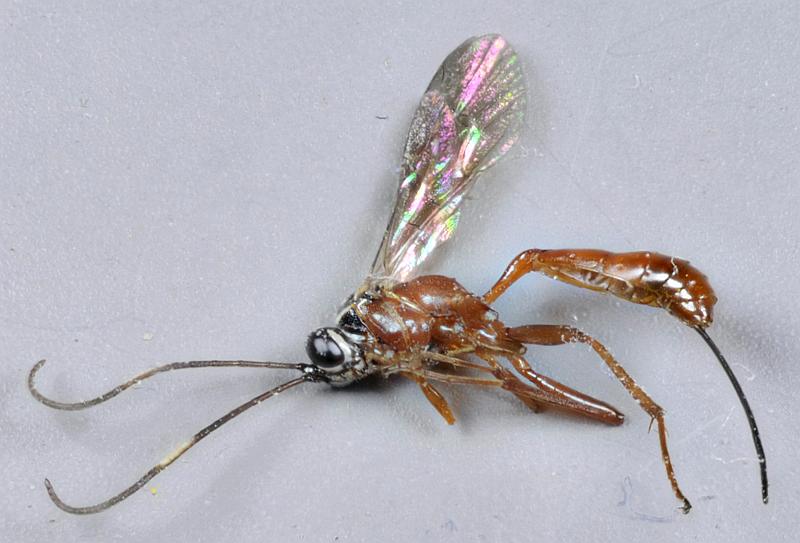

|
|
Ophion: These ichneumon wasps are one of the most common parasites of caterpillars here. They are attracted
to porch lights. Length 15 mm.
| |
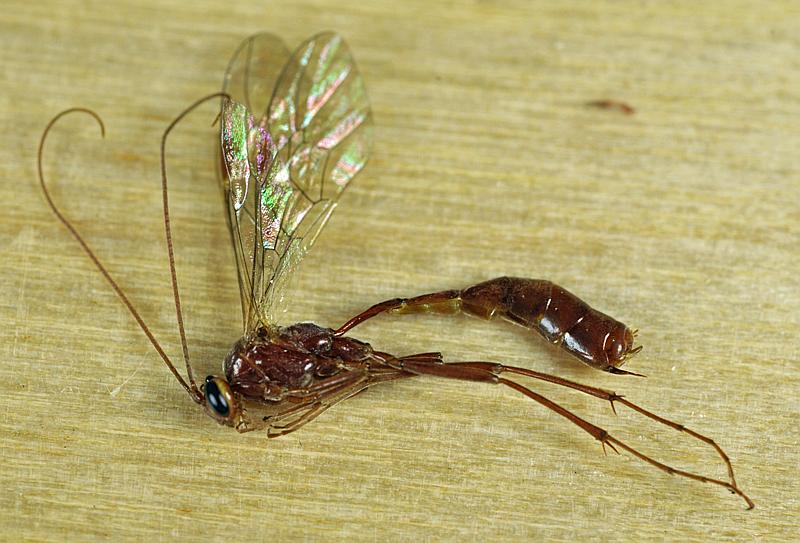

|
|
Passaloecus cuspidatus: These aphid wasps prefer aphid honeydew and carry aphids back to their nests to
feed their larvae. Ivory mandibles are a mark of the genus. Length 6 mm.
| |
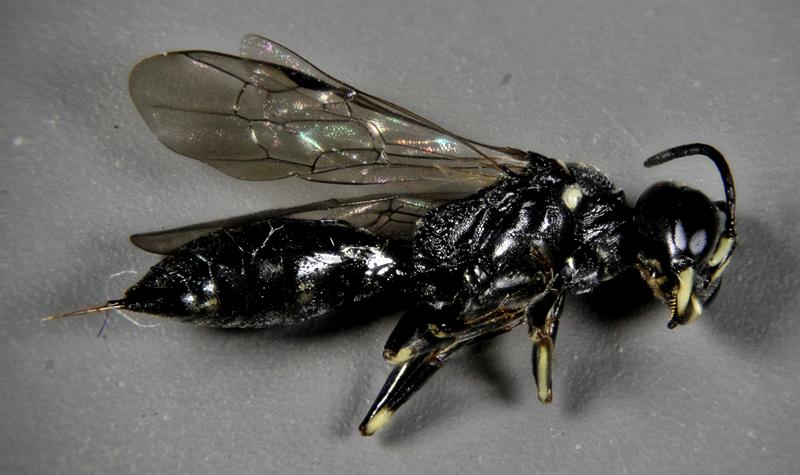

|
|
Pelecinus polyturator: This wasp thrusts its ovipositor into soil to detect a grub larva, lays one egg on
each. The wasp larva burrows into the beetle larva, killing it, then scavenges remains and pupates there in soil.
The long appendage is its abdomen, the ovipositor is quite short. Length 55 mm.
| |
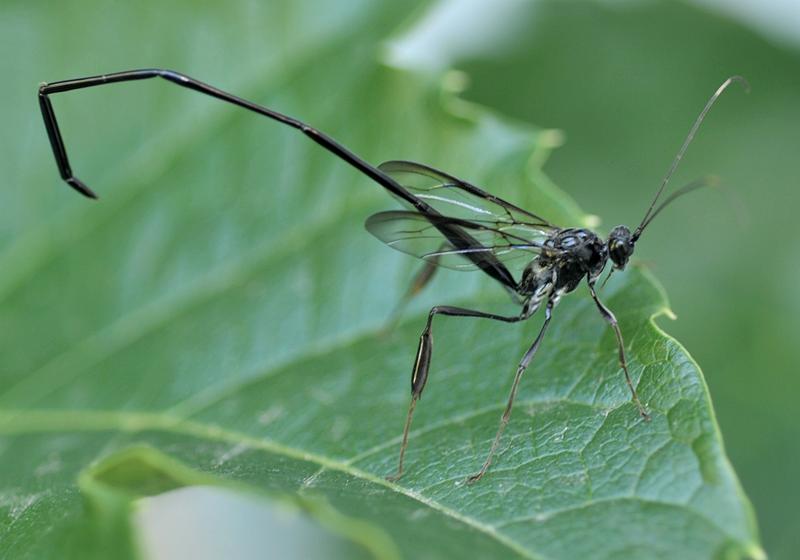

|
|
Philanthus gibbosus: Beewolves feed their larvae with small bees, especially Halictidae of which there
are many locally. Length 8 mm.
| |
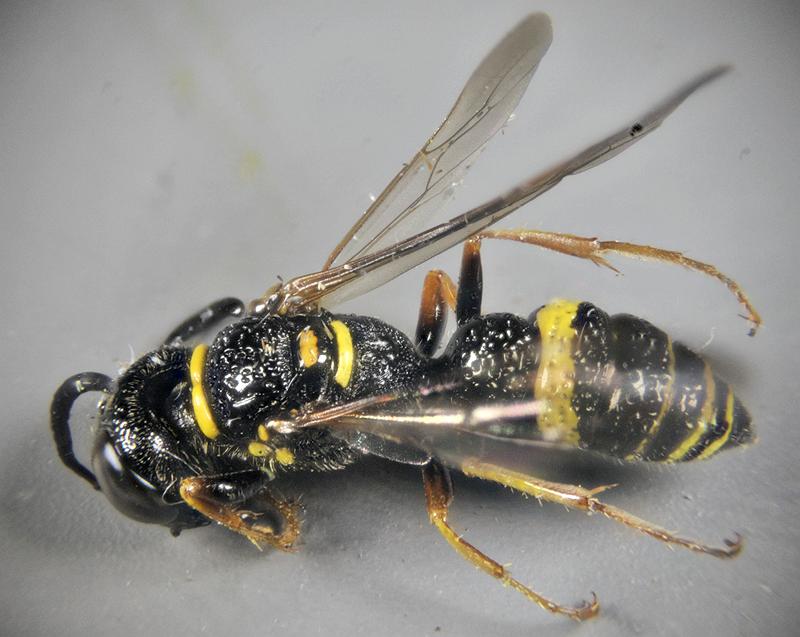

|
|
Polistes dominula: European Paper Wasps eat a wide variety of insects. They spend all their
time in the garden nosing into the leaf axils of Lilium to collect water, despite the presence of
a pond with floating vegetation that all the Vespula use. Length 15 mm.
| |
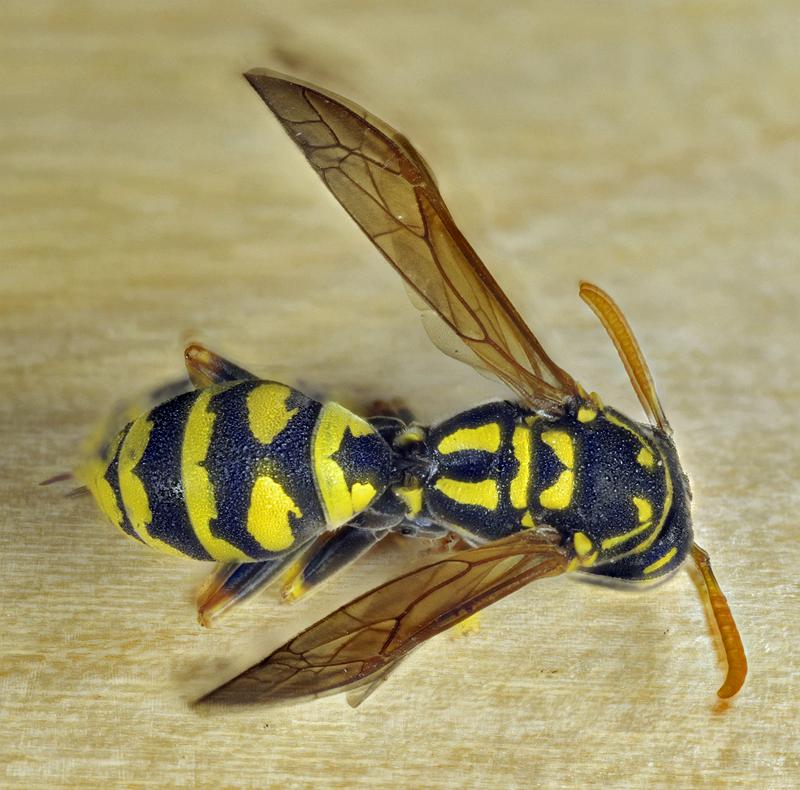

|
|
Polistes fuscatus: Northern Paper Wasps prey mostly on caterpillars. As do most paper wasps,
they use them solely to feed their larvae, sticking to nectar for their own energy. Length
14 mm.
| |
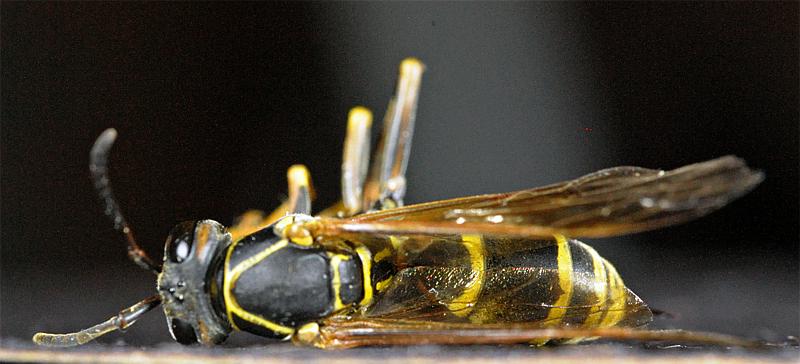

|
|
Prionyx atratus): The most powerful looking wasp I've ever seen - its mandibles are over 3 mm long
and it seems to spend all its time marching along the ground. A juicy grasshopper wouldn't stand a
chance in those claws. Length 29 mm.
| |
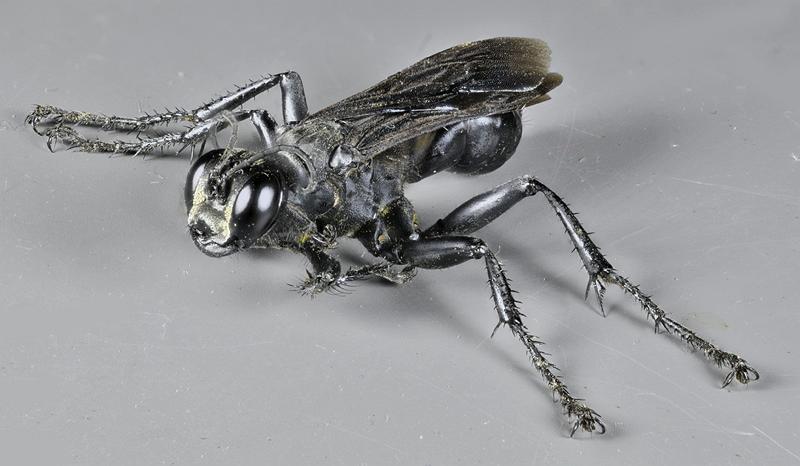

|
|
Sceliphron caementarium: Black And Yellow Mud Daubers build nests of mud in sheltered
locations such as under house eaves. Despite its fearsome appearance, it rarely stings anything
but spiders which it paralyzes as food for its larvae. Length 26 mm.
| |
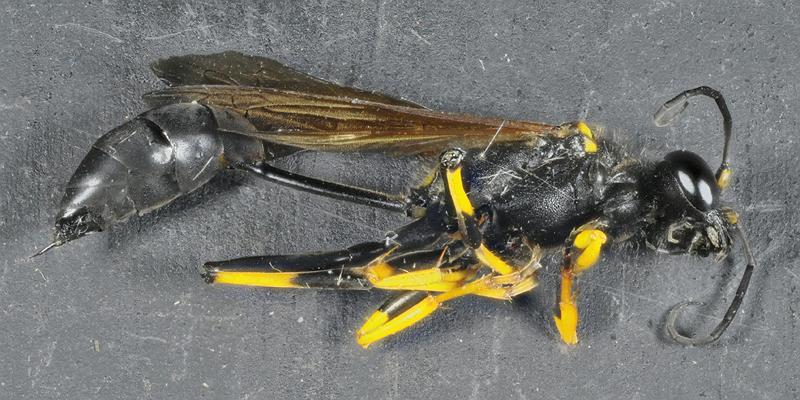

|
|
Sphex ichneumoneus: Great Golden Digger wasps feed their larvae with crickets and katydids,
but apparently only sip nectar themselves. Length 20 mm.
| |
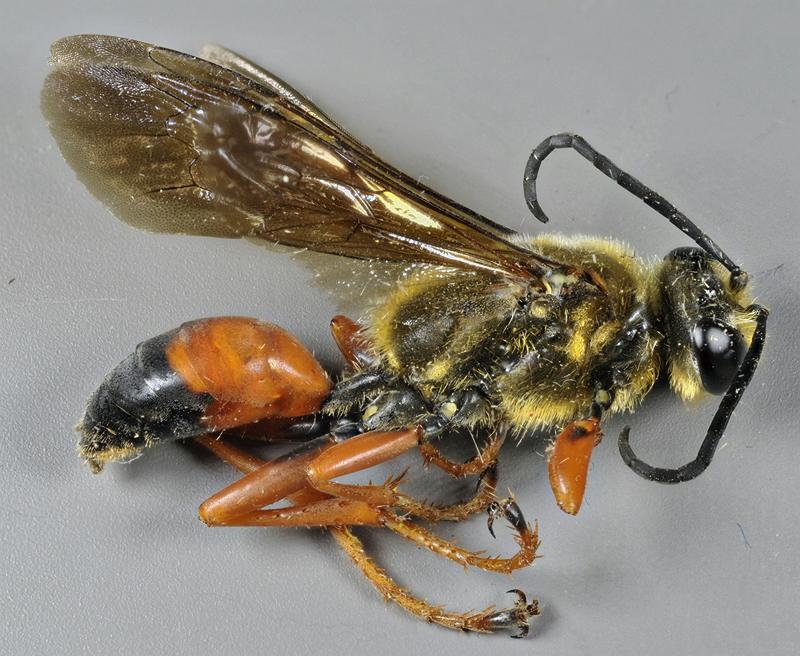

|
|
Stenichneumon culpator: An ichneumon wasp whose sole known prey is the larva of
Trichoplusia ni, the cabbage looper. Length 12 mm.
| |
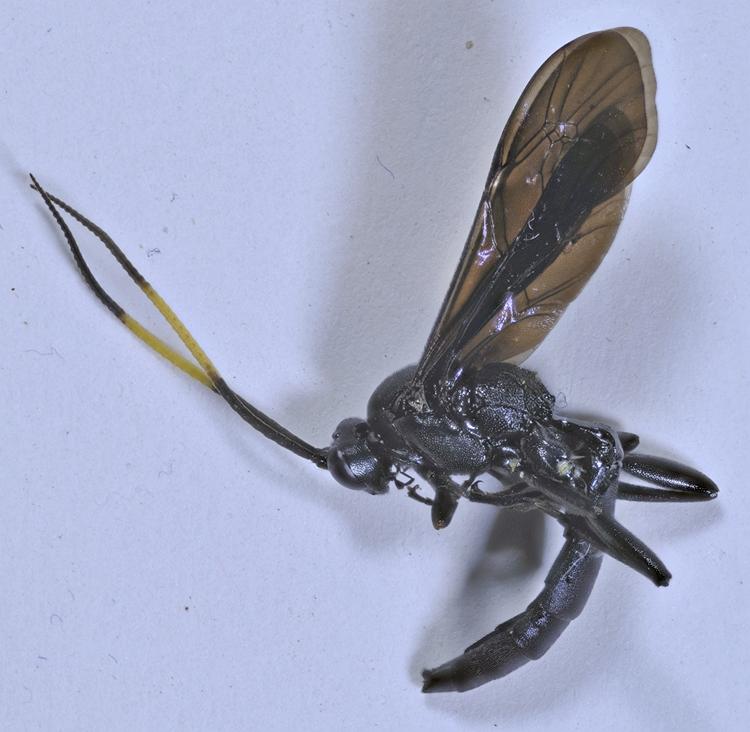

|
|
Therion circumflexum: This ichneumon wasp patrols a regular route around the garden looking
for Lepidoptera and Coleoptera larvae in which to raise its young. It's easily identified in flight
by its hanging yellow hind tarsi. Length 27 mm.
| |
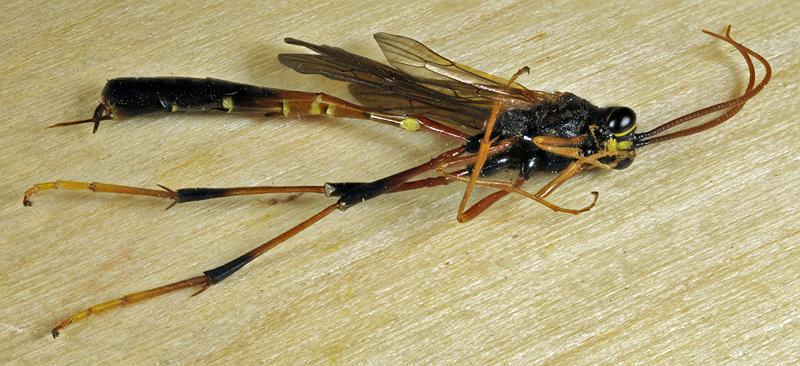

|
|
Thyreodon atricolor: A slow flying parasitoid of sphinx moth caterpillars, its laterally
flattened abdomen is distinctive. Length 35 mm.
| |
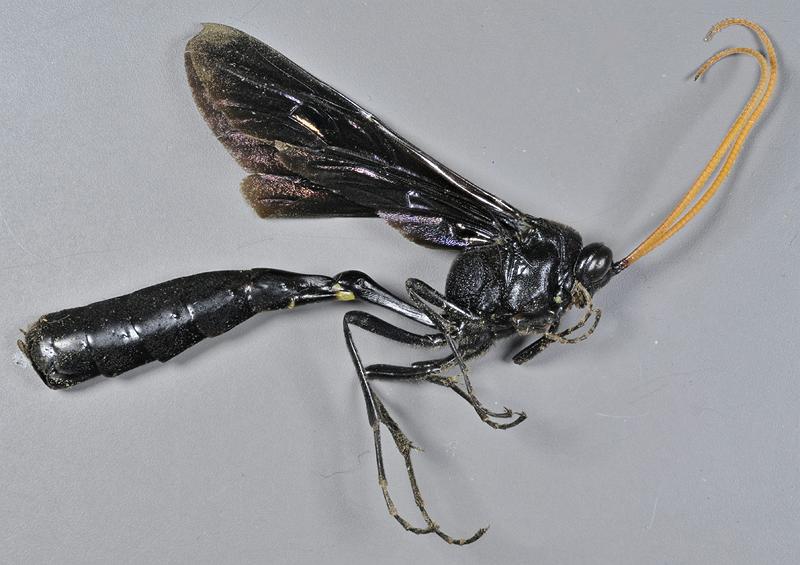

|
|
Vespa crabro:European Hornets are recent arrivals here; released in the New York area in the
mid-1800, they have been spreading ever since. Length 27 mm.
| |
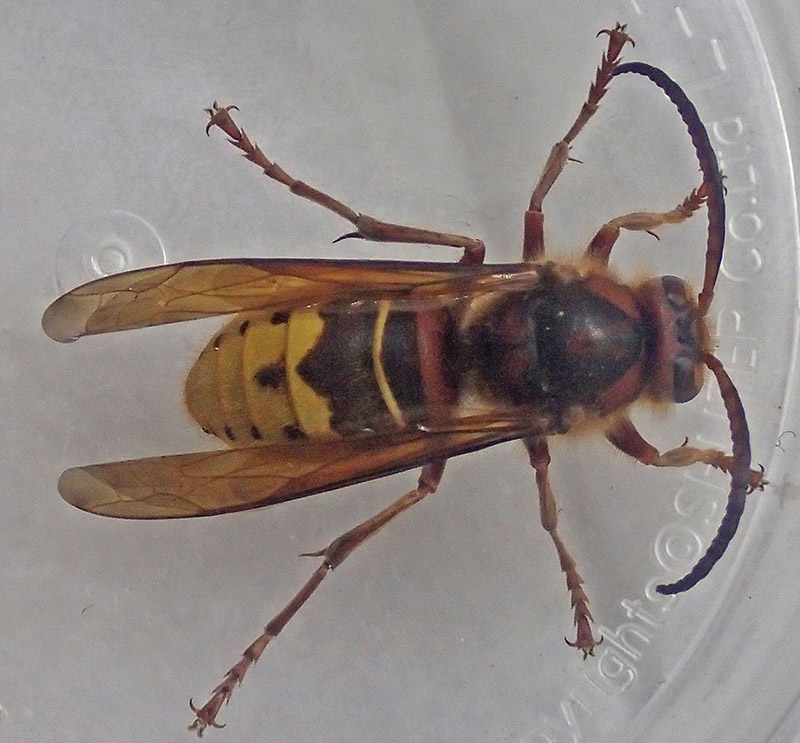

|
|
Vespula maculifrons: Eastern Yellow Jacket workers are common associates of picnics and
other outdoor food. This one is a queen, massive compared to the usual workers. Only queens
survive the winter; as soon as the first batch of workers can collect food, they remain in
their nest. Length 18 mm.
| |
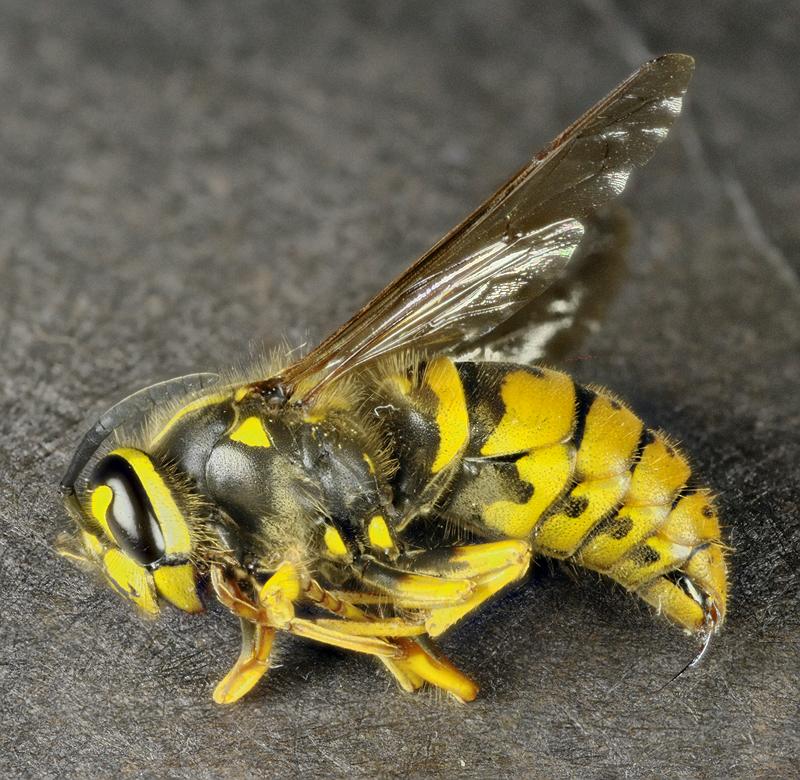

|




































































